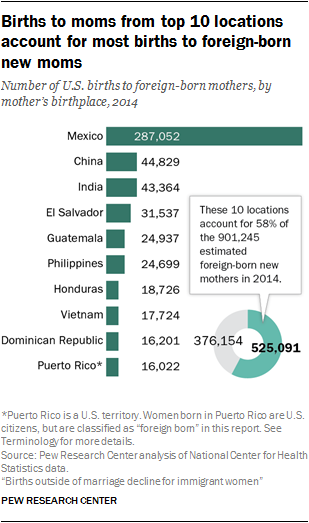 While the profile of new mothers varies by the region of the world in which they were born, even more dramatic differences emerge when comparing mothers from the top 10 countries,25 all of which are located in Latin America and Asia. Generally, new mothers from the top Asian countries are more likely to be married, highly educated and well-off financially than their counterparts from Latin America – for instance, marriage is virtually universal among new mothers from India, while fewer than half of those from the Dominican Republic or Puerto Rico are married. That being said, there are differences among new mothers from countries within the same region. Among new mothers from Asia, for example, those from India are more than twice as likely as those from Vietnam to have a bachelor’s degree.
While the profile of new mothers varies by the region of the world in which they were born, even more dramatic differences emerge when comparing mothers from the top 10 countries,25 all of which are located in Latin America and Asia. Generally, new mothers from the top Asian countries are more likely to be married, highly educated and well-off financially than their counterparts from Latin America – for instance, marriage is virtually universal among new mothers from India, while fewer than half of those from the Dominican Republic or Puerto Rico are married. That being said, there are differences among new mothers from countries within the same region. Among new mothers from Asia, for example, those from India are more than twice as likely as those from Vietnam to have a bachelor’s degree.
More than half of births to foreign-born women are to those from nine countries and Puerto Rico
Women hailing from just nine countries and one U.S. territory, all of which are located in Latin America and Asia, accounted for more than half (58%) of all births to immigrant mothers in the U.S. in 2014.
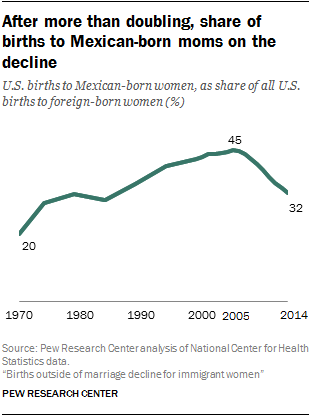 Mexico remains by far the dominant country of birth for new foreign-born mothers; about a third (32%) of all babies born to foreign-born mothers are to those who were born in Mexico.[26. And in fact, 7% of all U.S. births are to women who were born in Mexico.] To put that in perspective, the 287,000 births to Mexican-born women in 2014 outnumbered all births to women from Asia, Europe, North America and Oceania combined. China and India are the next most common origin countries – babies with mothers from these countries each account for 5% of births to the foreign born. Babies born to mothers originally from El Salvador, Guatemala and the Philippines account for 3% each; and those from Honduras, Vietnam, the Dominican Republic and Puerto Rico each account for about 2% of births to foreign-born mothers.
Mexico remains by far the dominant country of birth for new foreign-born mothers; about a third (32%) of all babies born to foreign-born mothers are to those who were born in Mexico.[26. And in fact, 7% of all U.S. births are to women who were born in Mexico.] To put that in perspective, the 287,000 births to Mexican-born women in 2014 outnumbered all births to women from Asia, Europe, North America and Oceania combined. China and India are the next most common origin countries – babies with mothers from these countries each account for 5% of births to the foreign born. Babies born to mothers originally from El Salvador, Guatemala and the Philippines account for 3% each; and those from Honduras, Vietnam, the Dominican Republic and Puerto Rico each account for about 2% of births to foreign-born mothers.
While Mexico has remained by far the most common country of birth for new foreign-born mothers in the U.S., the 32% of births to foreign-born mothers from this location in 2014 represents a fairly dramatic decline since 2005, when fully 45% of all babies born to foreign-born mothers were to those from Mexico.
A likely factor driving this recent decline is the dramatic impact that the Great Recession seemed to have on the fertility of Mexican-born women in the U.S. – their birth rates plummeted by 23% from 2007 to 2010. In comparison the overall U.S. birth rate dropped by 8% during that time, and the birth rate among all U.S. immigrants dropped by 14%. Meanwhile, the share of Mexican-born women of childbearing age in the U.S. dropped slightly, as overall Mexican immigration to the U.S. receded.
While the short-term decline in the share of foreign-born births to Mexican moms has been dramatic, in the long term, the share of births to Mexican-born mothers has risen substantially; it was 20% in 1970, when data first became available.
Marriage rates vary widely among mothers by birthplace
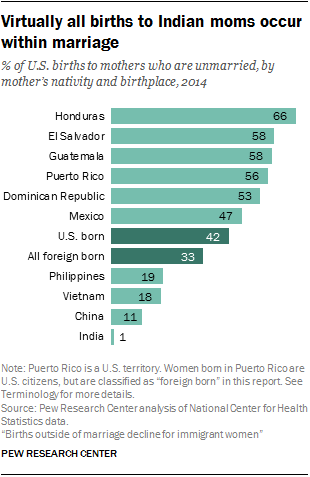 The likelihood of being unmarried varies significantly among new mothers from the top 10 sending locations. On the one hand, just 1% of new mothers from India are unmarried, according to NCHS data. Births outside of marriage are also quite uncommon for new mothers from the other top sending countries in Asia: 11% of new mothers from China are unmarried, as are 18% from Vietnam and 19% from the Philippines.
The likelihood of being unmarried varies significantly among new mothers from the top 10 sending locations. On the one hand, just 1% of new mothers from India are unmarried, according to NCHS data. Births outside of marriage are also quite uncommon for new mothers from the other top sending countries in Asia: 11% of new mothers from China are unmarried, as are 18% from Vietnam and 19% from the Philippines.
On the other hand, two-thirds of births to women from Honduras are to unmarried mothers. More than half of births to women from most other Latin American countries also occur outside of marriage. The exception is among women from Mexico: 47% of births to Mexican immigrants occur outside of marriage, a rate slightly higher than among births to U.S.-born mothers who are unmarried (42%).
Almost half of new mothers from Vietnam are ages 35 or older
 Foreign-born women who gave birth within the preceding 12 months are older, on average, than their U.S.-born counterparts – some 30% are ages 35 or older, compared with 18% among the U.S. born. Foreign-born new mothers originally from Vietnam (47%), the Philippines (41%) and China (37%) are particularly likely to be in this age range. Some 23% of new mothers from India are ages 35 or older – far below the shares found among new mothers from the other major Asian sending countries.
Foreign-born women who gave birth within the preceding 12 months are older, on average, than their U.S.-born counterparts – some 30% are ages 35 or older, compared with 18% among the U.S. born. Foreign-born new mothers originally from Vietnam (47%), the Philippines (41%) and China (37%) are particularly likely to be in this age range. Some 23% of new mothers from India are ages 35 or older – far below the shares found among new mothers from the other major Asian sending countries.
Mothers from major Latin American sending countries are less likely than foreign-born moms overall to be ages 35 or older. About one-fourth of new mothers from El Salvador (25%), Honduras (25%), Mexico (24%) and the Dominican Republic (23%) are at least 35 years old. Some 21% of new mothers from Guatemala are in this age range, as are 18% of those from Puerto Rico.
Mothers from Puerto Rico are about as likely as U.S.-born new mothers to be teenagers (7% vs. 6%). Teen mothers are less prevalent among those from other countries. The share reaches 4% among mothers originally from Mexico and the Dominican Republic, and 3% for mothers from El Salvador. Just 2% of those from Honduras and Guatemala are teen moms, and among new mothers from the remaining countries, the share is 1% or less.
New moms from India are, by far, the most likely to have bachelor’s degree and to be financially well-off
Among foreign-born women who gave birth in the preceding 12 months, educational attainment parallels financial well-being. New moms from India stand out on both measures – almost nine-in-ten (87%) have a bachelor’s degree, and their annual median incomes top $100,000. In contrast, new mothers from Honduras and Guatemala stand out as well – at least half lack a high school diploma, and about half are living in poverty.
 The Indian case is particularly extreme – none of the other top sending countries come close in terms of the share of new moms with a bachelor’s degree. Some six-in-ten new mothers from China and about half from the Philippines (52%) have this credential. About a third of new mothers from Vietnam (35%) have a bachelor’s degree, while 18% lack a high school diploma.
The Indian case is particularly extreme – none of the other top sending countries come close in terms of the share of new moms with a bachelor’s degree. Some six-in-ten new mothers from China and about half from the Philippines (52%) have this credential. About a third of new mothers from Vietnam (35%) have a bachelor’s degree, while 18% lack a high school diploma.
New mothers from each of the primary Latin American sending countries are less likely than new U.S.-born mothers (31%) to have a bachelor’s degree, and more likely than the U.S. born (12%) to lack a high school diploma. About one-fifth (22%) of new Puerto Rican-born mothers have a bachelor’s degree, and an equal share lack a high school diploma. The same share of new mothers from the Dominican Republic lack a high school diploma. Among new mothers from the remaining countries, it is far more common to lack a high school diploma than to possess a bachelor’s degree.
In terms of financial well-being, Indian-born new mothers have annual median family incomes more than twice as high ($104,500) as new U.S.-born mothers ($51,200). At the other end of the financial spectrum, just 4% of Indian-born new mothers are in poverty, compared with 26% of U.S.-born mothers.
New mothers from the Philippines, Vietnam and China are also relatively well-off. Those from the Philippines have annual incomes of about $75,000, those from Vietnam have incomes of about $70,000, and those from China have incomes of about $67,000. Poverty rates for new mothers from these countries range from 9% to 14%.
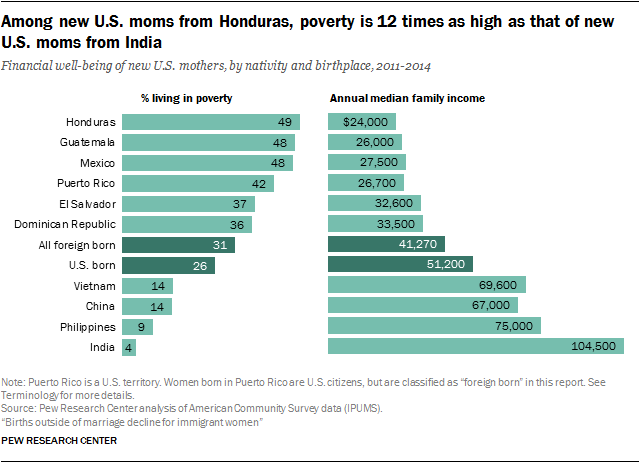
New mothers from the remaining countries, all located in Latin America, are less well-off than new U.S.-born mothers and new foreign-born mothers overall. Those from the Dominican Republic have incomes of about $33,500 a year, and those from El Salvador have incomes of about $32,600. Some 36% of those from the Dominican Republic are living in poverty, as are 37% of those from El Salvador. Incomes dip below $30,000 among new mothers from the remaining locations, and poverty is relatively high. Some 42% of new moms from Puerto Rico are living in poverty, while about half of those from Mexico (48%), Guatemala (48%) and Honduras (49%) are.
About four-in-ten new moms from Guatemala are English-proficient
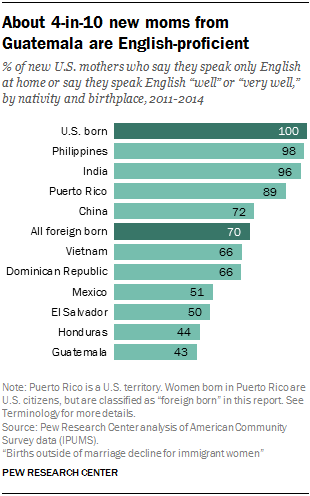 More than nine-in-ten mothers of newborns from the Philippines and India are English-proficient, meaning they speak English “well” or better. New moms from Puerto Rico are also highly likely to be English-proficient – 89% are.
More than nine-in-ten mothers of newborns from the Philippines and India are English-proficient, meaning they speak English “well” or better. New moms from Puerto Rico are also highly likely to be English-proficient – 89% are.
Rates of proficiency decline substantially for new mothers from the remaining countries of birth. The share is 72% for those from China, and two-thirds (66%) of new mothers from Vietnam and the Dominican Republic speak English at least “well.” About half of new moms from Mexico (51%) and El Salvador (50%) are English-proficient, as are 44% of those from Honduras and 42% of those from Guatemala.


